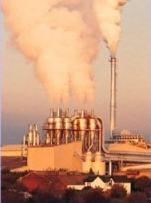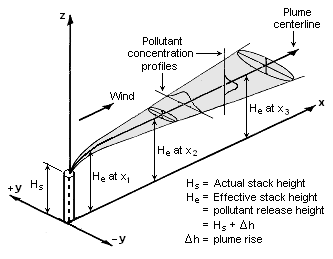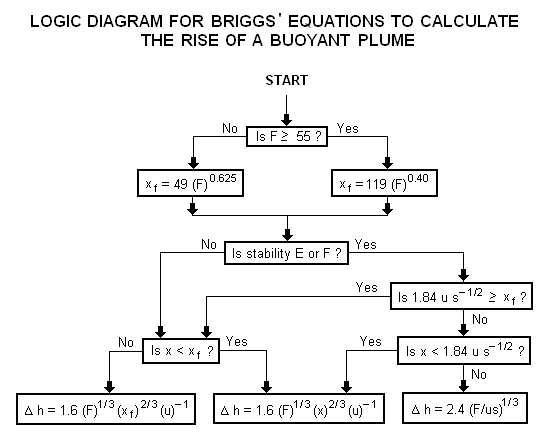Air pollution dispersion modeling/Citable Version: Difference between revisions
imported>D. Matt Innis (replace with approved version) |
imported>D. Matt Innis m (Protected "Air pollution dispersion modeling": approved [edit=sysop:move=sysop]) |
(No difference)
| |
Revision as of 19:29, 3 January 2009
Air pollution dispersion modeling is the mathematical simulation of how air pollutants disperse in the ambient atmosphere. It is performed with computer programs, called dispersion models, that solve the mathematical equations and algorithms which simulate the pollutant dispersion. The dispersion models are used to estimate or to predict the downwind concentration of air pollutants emitted from emission sources such as industrial plants and vehicular traffic. Such models are important to governmental agencies tasked with protecting and managing the ambient air quality. The models are typically employed to determine whether existing or proposed new industrial facilities are or will be in compliance with the National Ambient Air Quality Standards (NAAQS) in the United States and similar standards in other nations. The models also serve to assist in the design of effective control strategies to reduce emissions of harmful air pollutants.
The dispersion models require the input of data which includes:
- Meteorological conditions such as wind speed and direction, the amount of atmospheric turbulence (as characterized by what is referred to as the stability class, the ambient air temperature and the height to the bottom of any temperature inversion that may be present aloft.
- Emissions parameters such as source location and height, source vent stack diameter and exit velocity, exit temperature and mass flow rate.
- Terrain elevations at the source location and at the receptor location.
- The location, height and width of any obstructions (such as buildings or other structures) in the path of the gaseous emission plume.
Many of the modern, advanced dispersion modeling programs include a pre-processor module for the input of meteorological and other data, and many also include a post-processor module for graphing the output data and/or plotting the area impacted by the air pollutants on maps. Currently, the AERMOD air pollution dispersion model is the preferred regulatory model of the U.S. Environmental Protection Agency.
The air pollution dispersion models are also known as atmospheric dispersion models, atmospheric diffusion models, air dispersion models and air quality models.
Gaussian air pollutant dispersion equation
The technical literature on air pollution dispersion is quite extensive and dates back to the 1930's and earlier. One of the early air pollutant plume dispersion equations was derived by Bosanquet and Pearson.[1] Their equation did not assume Gaussian distribution nor did it include the effect of ground reflection of the pollutant plume.
Sir Graham Sutton derived an air pollutant plume dispersion equation in 1947[2] which did include the assumption of Gaussian distribution for the vertical and crosswind dispersion of the plume and also included the effect of ground reflection of the plume.
Under the stimulus provided by the advent of stringent environmental control regulations, there was an immense growth in the use of air pollutant plume dispersion calculations between the late 1960s and today. Since personal computers also came into existence during that period, a great many computer programs for calculating the dispersion of air pollutant emissions were developed in that same period. The basis for most of those models was the Complete Equation For Gaussian Dispersion Modeling Of Continuous, Buoyant Air Pollution Plumes shown below: [3][4]
| where: | |
| = crosswind dispersion parameter | |
| = | |
| = vertical dispersion parameter = | |
| = vertical dispersion with no reflections | |
| = | |
| = vertical dispersion for reflection from the ground | |
| = | |
| = vertical dispersion for reflection from an inversion aloft | |
| = | |
| = concentration of emissions, in g/m³, at any receptor located: | |
| x meters downwind from the emission source point | |
| y meters crosswind from the emission plume centerline | |
| z meters above ground level | |
| = source pollutant emission rate, in g/s | |
| = horizontal wind velocity along the plume centerline, m/s | |
| = height of emission plume centerline above ground level, in m | |
| = vertical standard deviation of the emission distribution, in m | |
| = horizontal standard deviation of the emission distribution, in m | |
| = height from ground level to bottom of the inversion aloft, in m | |
| = the exponential function , which equals approximately 2.71828, and is also known as Euler's Number |
The above equation not only includes upward reflection of the pollution plume from the ground, it also includes downward reflection from the bottom of any temperature inversion lid present in the atmosphere.
The sum of the four exponential terms in converges to a final value quite rapidly. For most cases, the summation of the series with m = 1, m = 2 and m = 3 will provide an adequate solution.
It should be noted that and are functions of the atmospheric stability class (i.e., a measure of the turbulence in the ambient atmosphere) and of the downwind distance to the receptor. The two most important variables affecting the degree of pollutant emission dispersion obtained are the height of the emission source point and the degree of atmospheric turbulence. The more turbulence, the better the degree of dispersion.
The resulting calculations for air pollutant concentrations are often expressed as an air pollutant concentration contour map in order to show the spatial variation in contaminant levels over a wide area under study. In this way the contour lines can overlay sensitive receptor locations and reveal the spatial relationship of air pollutants to areas of interest.
The Briggs plume rise equations
The Gaussian air pollutant dispersion equation (discussed above) requires the input of H (also known as the effective plume height, He) which is the pollutant plume's centerline height above ground level. He at any distance from the pollutant plume's source is the sum of Hs (the actual physical height of the pollutant plume's source point) plus ΔH (the plume rise due the plume's buoyancy) at that distance..
To determine ΔH, many if not most of the air dispersion models developed between the late 1960s and the early 2000s used what are known as "the Briggs equations." G.A. Briggs first published his plume rise observations and comparisons in 1965.[5] In 1968, at a symposium sponsored by CONCAWE (a Dutch organization), he compared many of the plume rise models then available in the literature.[6] In that same year, Briggs also wrote the section of the publication edited by Slade[7] dealing with the comparative analyses of plume rise models. That was followed in 1969 by his classical critical review of the entire plume rise literature,[8] in which he proposed a set of plume rise equations which have became widely known as "the Briggs equations". Subsequently, Briggs modified his 1969 plume rise equations in 1971 and in 1972.[9][10]
Briggs divided air pollution plumes into these four general categories:
- Cold jet plumes in calm ambient air conditions
- Cold jet plumes in windy ambient air conditions
- Hot, buoyant plumes in calm ambient air conditions
- Hot, buoyant plumes in windy ambient air conditions
Briggs considered the trajectory of cold jet plumes to be dominated by their initial velocity momentum, and the trajectory of hot, buoyant plumes to be dominated by their buoyant momentum to the extent that their initial velocity momentum was relatively unimportant. Although Briggs proposed plume rise equations for each of the above plume categories, it is important to emphasize that "the Briggs equations" which become widely used are those that he proposed for bent-over, hot buoyant plumes (as depicted in the adjacent diagram of a plume).
In general, Briggs's equations for bent-over, hot buoyant plumes are based on observations and data involving plumes from typical combustion sources such as the flue gas stacks from steam-generating boilers burning fossil fuels in large power plants. Therefore, the stack exit velocities were probably in the range of 20 to 100 ft/s (6 to 30 m/s) with exit temperatures ranging from 250 to 500 °F (120 to 260 °C).
A logic diagram for using the Briggs equations[4] to obtain the plume rise trajectory of bent-over buoyant plumes is presented below:
where: Δh = plume rise, in m F = buoyancy factor, in m4/s3 x = downwind distance from plume source, in m xf = downwind distance from plume source to point of maximum plume rise, in m u = windspeed at actual stack height, in m/s s = stability parameter, in s-2
The above parameters used in the Briggs' equations are discussed in much more detail by Beychok.[4]
Major air pollution dispersion models in current use
These are some of the major air pollution dispersion models currently being used. There are literally dozens of other models as well.
- ADMS 3: Developed in the United Kingdom
- AERMOD: Developed in the United States
- AUSPLUME: Developed in Australia
- CALPUFF: Developed in the United States
- DISPERSION2:Developed in Sweden
- ISC3: Developed in the United States
- LADM: Developed in Australia
- NAME: Developed in the United Kingdom
- MERCURE: Developed in France
- RIMPUFF: Developed in Denmark
The European Topic Centre on Air and Climate Change, which is part of the European Environment Agency (EEA), maintains an online Model Documentation System (MDS)that includes descriptions and other information for almost all of the dispersion models developed by the countries of Europe. The MDS currently contains 104 models developed in Europe (excluding the United Kingdom).[11] A compilation of dispersion models that have been developed worldwide is available in this article's Catalog subpage.
References
- ↑ Bosanquet, C.H. and Pearson, J.L., "The spread of smoke and gases from chimneys", Trans. Faraday Soc., 32:1249, 1936
- ↑ Sutton, O.G., "The problem of diffusion in the lower atmosphere", QJRMS, 73:257, 1947 and "The theoretical distribution of airborne pollution from factory chimneys", QJRMS, 73:426, 1947
- ↑ Turner, D.B. (1994). Workbook of Atmospheric Dispersion Estimates, 2nd Edition. CRC Press. ISBN 1-56670-023-X. www.crcpress.com
- ↑ 4.0 4.1 4.2 Beychok, Milton R. (2005). Fundamentals of Stack Gas Dispersion, 4th Edition. author-published. ISBN 0-9644588-0-2. www.air-dispersion.com
- ↑ Briggs, G.A., "A plume rise model compared with observations", JAPCA, 15:433-438, 1965
- ↑ Briggs, G.A., "CONCAWE meeting: discussion of the comparative consequences of different plume rise formulas", Atmos. Envir., 2:228-232, 1968
- ↑ Slade, D.H. (editor), "Meteorology and atomic energy 1968", Air Resources Laboratory, U.S. Dept. of Commerce, 1968
- ↑ Briggs, G.A., "Plume Rise", USAEC Critical Review Series, 1969
- ↑ Briggs, G.A., "Some recent analyses of plume rise observation", Proc. Second Internat'l. Clean Air Congress, Academic Press, New York, 1971
- ↑ Briggs, G.A., "Discussion: chimney plumes in neutral and stable surroundings", Atmos. Envir., 6:507-510, 1972
- ↑ The Model Documentation System (MDS)
Further reading
For those who would like to learn more about this topic, it is suggested that either one of the following books be read:
- Turner, D.B. (1994). Workbook of Atmospheric Dispersion Estimates, 2nd Edition. CRC Press. ISBN 1-56670-023-X. www.crcpress.com
- Beychok, Milton R. (2005). Fundamentals of Stack Gas Dispersion, 4th Edition. author-published. ISBN 0-9644588-0-2. www.air-dispersion.com
- Schnelle, Jr., Karl B. and Dey, Partha R. (2000). Atmospheric Dispersion Modeling Compliance Guide. McGraw-Hill. ISBN 0-07-058059-6.
- Pages using ISBN magic links
- Subpages
- Engineering Extra Subpages
- Earth Sciences Extra Subpages
- Chemical Engineering Subgroup Citable Versions
- Environmental Engineering Subgroup Citable Versions
- Engineering Approved Extra Subpages
- Earth Sciences Approved Extra Subpages
- Citable versions of articles
- Engineering Citable Version Subpages
- Earth Sciences Citable Version Subpages
- All Content
- Engineering Content
- Earth Sciences Content
- Chemical Engineering tag
- Environmental Engineering tag



![{\displaystyle \exp \;[-\,y^{2}/\,(2\;\sigma _{y}^{2}\;)\;]}](https://wikimedia.org/api/rest_v1/media/math/render/svg/e8925630e3b8de6be025fb258aa809189a852082)



![{\displaystyle \;\exp \;[-\,(z-H)^{2}/\,(2\;\sigma _{z}^{2}\;)\;]}](https://wikimedia.org/api/rest_v1/media/math/render/svg/32be81e17b8659fb72ef85e886a95c57401160bd)

![{\displaystyle \;\exp \;[-\,(z+H)^{2}/\,(2\;\sigma _{z}^{2}\;)\;]}](https://wikimedia.org/api/rest_v1/media/math/render/svg/b8359e355bf985dc7714abecb7a250155e07b62f)

![{\displaystyle \sum _{m=1}^{\infty }\;{\big \{}\exp \;[-\,(z-H-2mL)^{2}/\,(2\;\sigma _{z}^{2}\;)\;]}](https://wikimedia.org/api/rest_v1/media/math/render/svg/37cb296347f56a0618c59d247cbf00125fc3de8c)
![{\displaystyle +\,\exp \;[-\,(z+H+2mL)^{2}/\,(2\;\sigma _{z}^{2}\;)\;]}](https://wikimedia.org/api/rest_v1/media/math/render/svg/8546ac2627ada5bfebad51a692c902206a5efa2c)
![{\displaystyle +\,\exp \;[-\,(z+H-2mL)^{2}/\,(2\;\sigma _{z}^{2}\;)\;]}](https://wikimedia.org/api/rest_v1/media/math/render/svg/1fe6a89e17f16835d86e8d9a8971a74db46d1e4b)
![{\displaystyle +\,\exp \;[-\,(z-H+2mL)^{2}/\,(2\;\sigma _{z}^{2}\;)\;]}](https://wikimedia.org/api/rest_v1/media/math/render/svg/cfddc08fc6cf6d11e6d3dc421a0fead1fe6e0160)










